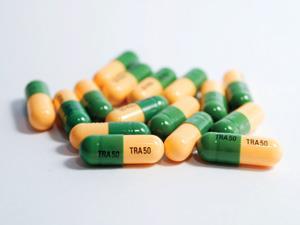Meera Senthilingam
This week, an asthmatic's elixir, as Andrea Sella takes us back to his childhood:
Andrea Sella
I don't often talk about it, but I was almost a child mortality statistic. Now that I have children of my own, that phrase is all the more chilling, and it makes me realise the agony that my parents once went through.
Let me explain. As an infant and a toddler I would suffered from colds in the wintertime. Within a day or two I would start coughing, and then the wheezing would start – a periodic high pitched hiss emanating from my chest – a sound that filled my parents with dread. My father, a medic by training, tried hard not to over-react. But one night things got so bad that my parents called our GP. By chance he was on duty at the hospital just across the street. He nipped up to our flat, took one look at me and, without a word, picked me up and dashed to the emergency ward. It would be the first of many occasions when I would be placed in an oxygen tent.

I have no memory of this, of course, and slowly the problem receded. When I was about seven, however, our family was invited to spend a week with our friends, the Thompsons, in snowy, mountainous Vermont, US. They had a romantic old chalet on the edge of a forest. There was a meadow and a frozen pond. For us children it was heaven.
On the first night we were there I woke up suddenly with a sense of unspeakable terror. I couldn't breathe. Try as I might to inhale, nothing happened. I panicked and looked for my mum. The light was on but she wasn't there. Desperate I started to flail my arms hoping to get some relief. My mother came in, took one look at me and in a swift movement opened the window, picked me up and shoved me onto the snowy roof outside. The icy air blasted me - moments later I could breathe again. I still remember the darkness, the cold, and the snow on my toes.
Next morning, a doctor suggested that it was an allergy, probably to the Thompsons' cat. For the itching he prescribed antihistamines that made me impossibly sleepy. But for the asthma there was nothing he could do. The few drugs available were either very short lived or had significant cardiac side effects.
I spent the rest of the holiday having my meals alone on the picnic table outside the house – my friends were rather envious of my adventurous privilege. At night I slept with my pillow propped on the edge of the open window.
It was not until two years later that I went back to the Thompsons' house. But by then everything was different. They still had their cat, but I could cope.

The secret lay in the discovery of the beta adrenoreceptors in muscle tissue. These receptors, which would naturally bind adrenaline to control muscle contraction, were found to come in two types: the type 1 were mostly located in heart muscle, while the type 2 were to be found in the smooth muscles – particularly those of the bronchi, the small and medium sized airways in the lungs. Certain molecules – the beta agonists or stimulants – can bind to these receptors and, in a complex cascade of steps, cause the muscle to relax. The realisation that it might be possible to modulate the action of these involuntary muscles made these beta receptors an exciting target for pharmacologists, especially since the discovery of the two types suggested that selective action might be possible.
In 1968, the British firm of Allen and Hanbury's (now part of GSK) announced the launch of a new drug – Ventolin – as a bronchodilator. The active ingredient was a molecule called (RS)-4-[2-(tert-butylamino)-1-hydroxyethyl]-2-(hydroxymethyl)phenol, known rather more pronounceably as salbutamol, or albuterol in the US. What made it special is that it acted on the beta-2 receptor 500 times as strongly as on the beta-1, ensuring that while the airways relaxed, the heart was unaffected. The drug could be administered as tablets, but it acted much more quickly as an inhaled aerosol.
I remember our GP showing me the blue-grey puffer and explaining how I should exhale as far as I could, and then while inhaling slowly, squeeze the small canister to release a single puff of aerosol. If the taste was faintly medicinal, the effect was astonishing: within seconds, the wheeze would be gone. My laughter would change from a shallow giggle to a hearty belly laugh. The drug proved an absolute blockbuster. Almost 50 years later it's famous for its fast action and unusual lack of side-effects. Indeed, many pharmacologists argue that it has never been superseded, although alternative strategies now exist for managing asthma.
But salbutamol has a darker side. Exercise too can cause bronchostriction. So it was not long before someone realised that chemically relaxing the muscles of the bronchi might help breathless athletes go further and faster. The result was that beta-2 agonists started being used widely in track and field athletics, cycling, and swimming, to boost performance.
In 1993, the International Olympic Committee banned beta-2 agonists. Yet because they are so important in everyday medicine, the sporting authorities introduced the Therapeutic Use Exemption which allowed athletes with medical problems to take these drugs to treat their condition.

After the 1998 Winter Olympics, it was found that the number of athletes registered as suffering from asthma, and therefore eligible for the exemption, had risen by an astonishing 60 per cent. Salbutamol therefore became one of the very few drugs governed by two regimes. Any athlete with urine content of over 100ng/ml of the drug metabolites would be issued with a warning. But if that level exceeded 1000ng/ml it would result in a ban, in part because at these levels salbutamol starts to have muscle-building or anabolic effects. In 2010, the lower limit was lifted in light of evidence casting doubt on its performance-enhancing effects. Athletes need now only declare using salbutamol for medicinal purposes when asked for a drugs test.
The debate in sport will go on and on. But for those of us with asthma, salbutamol is almost the elixir of life. The inexorable rise in the prevalence of asthma has led to a steady widening in the strategies for managing the condition. But salbutamol remains at the heart of it. If you look in my cycling panniers you will always find one of those little blue inhalers. I use it maybe once a year.
Meera Senthilingam
So clearly a useful compound to have around – especially if you're asthmatic. That was UCL's Andrea Sella with the blockbuster chemistry of salbutamol. Now, next week, we go a little further back in time to the origins of manufacturing.
Brian Clegg
When early humans first began to produce tools and other artefacts, they were limited to stone and living matter – whether wood, plant material or animal-based – as the basis for their manufacturing. With time, the ability to heat materials and process them added metals, glass and ceramics like pottery to that line up. But for a good 2000 years there was nothing else available. In the early 1900s a sixth type of substance, the first truly artificial manufacturing material, joined the original five. It was called bakelite.
Meera Senthilingam
And to find out the chemistry and many uses of bakelite, join Brian Clegg in next week's Chemistry in its element. Until then, thank you for listening. I'm Meera Senthilingam.













No comments yet